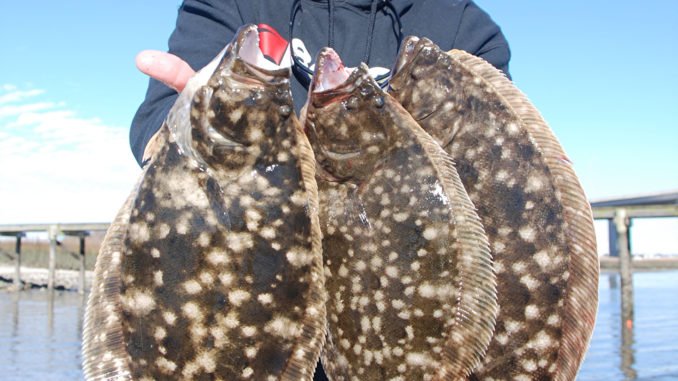
Cooling weather sends flatfish out of backwaters toward big waters in the waters around Charleston. Here’s how to intercept them on their migration
Autumn is largely the favorite season for many die-hard saltwater anglers. Summer crowds have mostly vacated the coast, and baitfish begin making their seasonal migrations out of estuaries and into more open water.
While many anglers dream of double armloads of adult redfish or 100-trout days, the lowly flounder tends to get overlooked. But like reds and trout, flounder also find themselves on the move in response to cooler water and baitfish migrations.
Guide John Boy Koonce of Shoal Bandit Charters warns anglers not to make the mistake of thinking the mullet run is just for redfish and shrimp migrations are only for trout.
“He might not be swimming around the same way as a redfish or trout, but ol’ Mr. Flounder’s down there wanting to eat just like everybody else,” said Koonce, whose go-to baits for fall flounder are finger mullet and mud minnows, the latter because Charleston bait and tackle shops usually plenty.
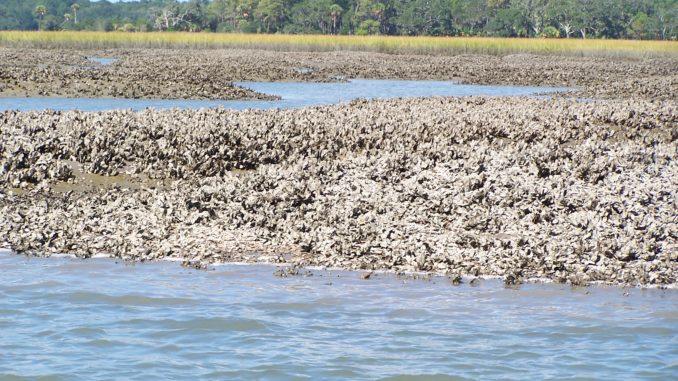
“I prefer a lightweight Carolina rig,” he said. “I’ll go with a ¼-ounce weight on a foot-and-a-half leader.
Koonce’s favorite spots for October flounder are live oyster points in the bigger, wider creeks around the Charleston area. He prefers live oyster shell, what he describes as darker shell, over points that are covered with dead shell that have been sun-bleached to a near white.
“I look for gaps in the live oyster shell, someplace that flounder can get in between the shell and lay up,” Koonce said. “I don’t like mud bottom, either that or areas where you find the black grass. Flounder don’t like either one of those, but they love the live oyster shell and will even lay on top of it sometimes.”
Koonce approaches the structure so he’s parallel to it, wanting to cast along the edge of the shell where it meets the bottom. He prefers to fish the bottom two hours of a falling tide and the first two hours of a rising tide.
“I want to get him out in the open, away from the grass and away from the docks, and get him out where there’s still some live shell in the water,” he said. “I think they like that better, too, because the baitfish have nowhere to hide. A flounder can lay in a foot-and-a-half of water and eat all he wants.”
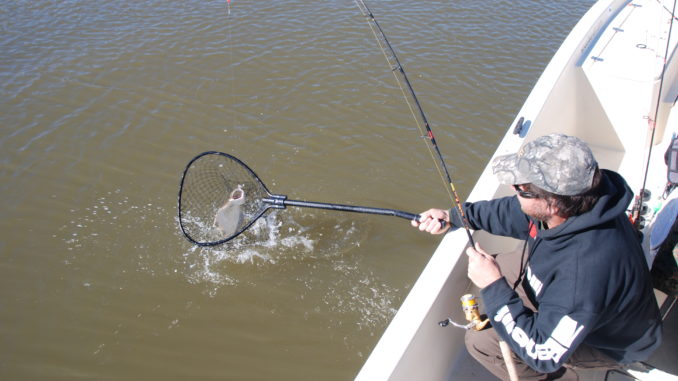
Koonce’s other favorite spots are along sea walls or an area where a homeowner has brought in riprap to line his property. Both make for good, hard, edges, and flounder love position themselves along the edge.
Koonce said Bass Creek around Kiawah Island, Hobcaw Creek off the Wando River, Yellowhouse Creek off the Cooper River, and James Island Creek on the back of James Island as good floundering spots.
“You have to be real careful with the Carolina rig, because it’ll hang up pretty easy,” he said. “If I’m fishing a good area, I might even rig a slip float so the bait is set just above the structure. You end up catching more mixed bags that way, but you’ll find your share of flounder with a cork, too.”
If guide Wilson Hanna of Redfin Charters had nothing but a hook to fish with for fall flounder, he’d want to make double sure it was a gold hook. He swears by gold Kahle hooks in sizes 3/0 to 5/0 for flatfish, and even though he’s never caught a flounder on a bare hook, his catch rates are substantially better when the gold hook is paired with a finger mullet or large mud minnow.
“If I’m fishing shallow water, 2 to 4 feet, I’m fishing smaller baits, and if I’m fishing deeper water, 10 to 25 feet deep, I’m using bigger baits,” Hanna said. “Either way, I’m going with a gold hook.”
Hanna likes to hit different spots and cast a baited Carolina rig to catch flounder, and like Koonce, he loves edges. He said that flounder don’t care for the plough mud that’s so prevalent around Charleston, but anywhere there’s a change from mud to sand or sand to shell is a good place to look for flounder.
“Flounder can’t bury themselves well in mud, but sand or loose shell is different,” he said. “Look for edges where you can see them on the bank or look for drop-offs where the water is too deep to see.”
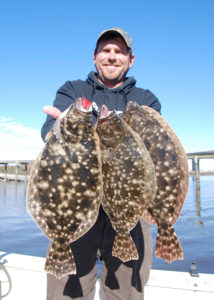
In deeper water, Hanna looks for drop-offs in the back of a creek. Mud flats generally don’t slope, so if he finds a good slope, chances are excellent it’s either hard sand, rock, livebottom or something besides mud. With the right electronics, an angler can pick up the different bottom, but for the average guy out in a creek in a small boat, just look for steep slopes or drop-offs on your screen.
“If you want to check out an area in advance, go back there on a negative tide and scout the area when there’s no water on it,” said Hanna. “Makes some notes and come back and fish it when the water is right.”
For shallow water, he may use a simple split-shot rig, using the biggest split shot he can find, usually a No. 2 or No. 3 on 10- to 12-pound line. For fishing ledges, he’ll go with up to a ¾-ounce egg sinker ahead of a 30-pound leader with a 3/0 hook.
Hanna prefers an incoming tide because it’s bringing fresh water — either cooler or warmer, depending on the season — and that attracts flounder. In the fall, the incoming tides really produce after the first, good cold front and starts moving flounder out of the backs of creeks and towards open water.
Hanna said he’s also fond of keeping logs on his flounder catches.
“Most people around Charleston catch flounder by accident,” he said. “But there’s a reason you caught that fish. There’s a trend in there somewhere. Either your bait crossed a transition area or a little drain that was deeper than the surrounding area and free of mud, or something that fish liked.”
“Figure that out, and your percentages of catching flounder will go way up.”
DESTINATION INFORMATION
HOW TO GET THERE — Charleston is best accessed from US 17 and I-26. Convenient public boat ramps are Remley’s Point on the Wando River in Mount Pleasant, just north of US 17, Shem Creek off SC 703 in Mount Pleasant, and Wappoo Cut on Wappoo Creek between West Ashley and James Island off SC 171.
WHEN TO GO — September and October are prime months to catch flounder in the waters around Charleston, with the action lasting into November if mild weather persists.
BEST TECHNIQUES — As fall arrives, flounder will follow baitfish out from shallow creeks and head in the general direction of the ocean. Look to find flounder around channel and marsh edges. Flounder have a hard time hiding in mud but will lie next to a mud line in sand or shell and wait for prey to pass by. An area where live oyster shell meets sand is also a likely flounder holding spot. For deeper areas, look for drop-offs and fish the down slope with the current in the fish’s face. Favorite baits are finger mullet or larger mud minnows fished on a Carolina rig.
FISHING INFO/GUIDES — John Koonce, Shoal Bandit Charters, 843-425-2939, www.shoalbandit.com; WIlson Hanna, Redfin Charsters, 843-277-5255, www.inshorefishingcharters.com, 843- 277-5255. See also Guides & Charters in Classifieds.
ACCOMMODATIONS — Best Western Patriots Point, Mount Pleasant, 843-971-7070; Town and Country Inn & Conference Center, Charleston, 800-334-6660; La Quinta Inn & Suites, Charleston, 843-556-5200.
MAPS — Maps Unique, 910-458-9923, www.mapsunique.com; Sealake Fishing Guides, 800-411-0185, www.thegoodspots.com.

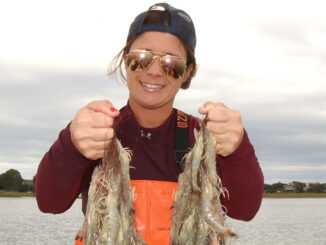
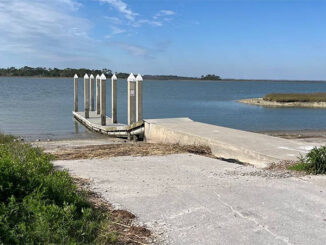
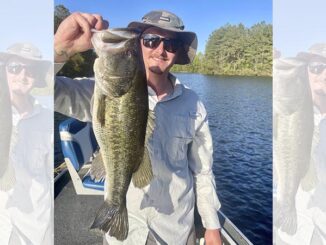

Be the first to comment